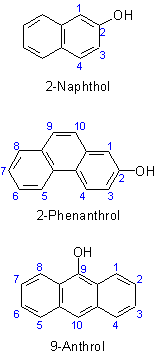
ACD/Name (Chemist Version) offers a standardized set of features for quick and simple generation of IUPAC names, and structures from names. It is a streamlined version of our popular ACD/Name software.
View a full description and pricing on our web store.

 , as the principal characteristic
group is indicated by adding a suffix, such as "-ol", "-diol", etc., as appropriate, to the name of the parent hydride with elision of a terminal "e" before a following vowel.
, as the principal characteristic
group is indicated by adding a suffix, such as "-ol", "-diol", etc., as appropriate, to the name of the parent hydride with elision of a terminal "e" before a following vowel.
When a group having priority for citation as the principal characteristic group is also present, hydroxy groups are indicated by the prefix "hydroxy-".Examples to R-5.5.1.1
Methanol
Benzene-1,2,4-triol
Butane-1,3-diol
Cyclohex-2-en-1-ol
Benzenehexol [see R-0.1.7.1(c)][see R-0.1.7.1(c)]
Bicyclo[4.2.0]octan-3-ol
Quinolin-8-ol
Chrysen-1-ol
Functional class names for alcohols consist of the substituent prefix derived from the name of the corresponding parent hydride followed by the class name "alcohol" cited as a separate word.Examples to R-5.5.1.1
The following contracted names are retained for the structures shown and their positional isomers.Examples to R-5.5.1.1

Some trivial names are retained (see R-9.1, Table 26(a)).
R-5.5.1.2 Sulfur, selenium, and tellurium analogues of alcohols and phenols are named in the same way by using suffixes such as "-thiol", "-selenol", and
"-tellurol" , and prefixes such as "sulfanyl-", "selanyl-", and "tellanyl-" to designate the characteristic groups
, and prefixes such as "sulfanyl-", "selanyl-", and "tellanyl-" to designate the characteristic groups  ,
,  , and
, and
 , respectively
, respectively .
.
Examples to R-5.5.1.2



Published with permission of the IUPAC by Advanced Chemistry Development, Inc., www.acdlabs.com, +1(416)368-3435 tel, +1(416)368-5596 fax. For comments or suggestions please contact [email protected]